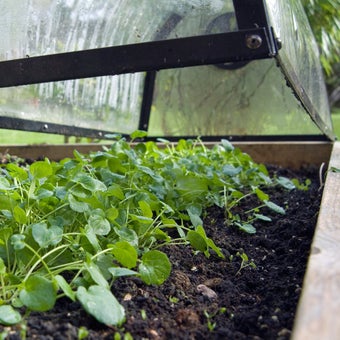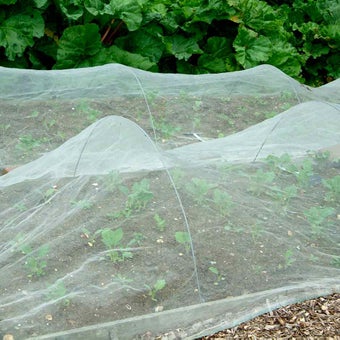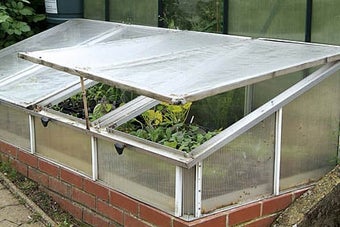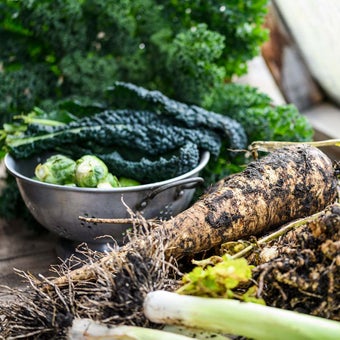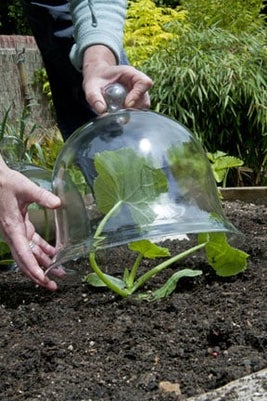
Quick facts
is French for ‘bell’; the first cloches were glass bells
Cloches act like little greenhouses
- Cloches protect over-wintered and early vegetables from weather
Tender crops such as cucumbers and peppers can be covered all summer
- By keeping off rain diseases can be prevented
Why use cloches
Cloches function in the same way as greenhouses and polytunnels but on a miniature scale. Unlike coldframes and mini-greenhouses they are normally easy to move around.
They are used to protect rows of low growing plants such as vegetables, strawberries and cut flowers, or cover individual plants in ornamental gardens. At the start of the year seedbeds and can be covered. But at the other end of the season taller cloches promote ripening of aubergines, tomatoes and peppers. Cucumbers and dwarf French beans in particular grow very well under cloches, making them successful crops in northern gardens where uncovered crops are unreliable.
Cloches also offer a good environment for striking and seedlings.
Unlike well constructed greenhouses cloches can blow away if not well anchored.
Advantages
Raising temperatures
Pre-warming the soil in spring can help crops to germinate earlier than usual, increasing the length of the cropping season (3-4 weeks at either end), and making maximum use of available ground. For example, a can raise the local soil temperature by up to 10°C and hasten of direct-sown crops by 10-14 days. This, in turn, raises air temperatures and also reduces the amount of heat lost at night, resulting in earlier harvest dates (3-4 weeks with most crops).
Ideally, cloches and other soil warming measures should be in place at least one week before any crops are or sown into the soil, to allow temperatures underneath to rise sufficiently. Temperatures near the surface will tend to fluctuate but lower soil levels will retain some of the accumulated warmth. Glass cloches are especially effective as they retain more warmth at night.
Weather protection
Wind protection increases growth rates and leaf surface area, and also promotes ‘softer’ growth. This is useful for leafy crops such as salads, spinach and cabbage where soft growth is desirable. If exposing such crops it is essential to harden them off as lush plants quickly wilt if suddenly exposed to strong wind or sunshine. To do this lift the lids and sides of plastic and cloches to increase for a week or so before exposing fully, and remove rigid plastic or glass cloches for a few hours each morning a week before full exposure.
Cloches keep off hail that can damage young plants and deflect heavy rain that can damage soil structure, seedbeds, young plants and contaminate produce with splashed soil.
Pest and disease protection
Used as a physical barrier, cloches can be a useful way of protecting crops from specific pests or diseases. Cloches are less effective than fleece or insect proof mesh at excluding pests but will prevent bird damage.
Well-ventilated cloches can reduce common air-borne diseases such as onion downy mildew and tomato blight by reducing wetting by rain. Foliar diseases need adequate moisture on the crop foliage to infect so keeping leaves dry is a good preventative measure; just aim to reduce through good ventilation too (e.g. opening any air vents, or lifting up a side of the cloche).
Over-wintering and ripening crops at the end of the season
Cloches offer frost and rain protection of autumn-sown crops such as carrots and chicory. They 'buffer' temperature for late-ripening crops such as bush tomatoes and chillies too, reducing the sharpness of early frosts.
Cloches covered with black polythene can be used to blanch endive and chicory, where the bitterness of these leafy salads is diminished and succulence increased by excluding light for several weeks.
Black plastic clad cloches can also be stuffed with straw or other insulating material and placed over root crops to keep them sound and accessible in freezing winter weather.
Disadvantages
Cloches have many of the same downsides as and other crop covers. These include;
Humidity and watering
Raised levels and subsequent soft, lush growth produced when growing under cloches encourages diseases such as Botrytis and downy mildew unless the ventilation is very efficient. The accompanying higher temperatures and abundance of lush foliage also create an ideal environment for many pests. When buying cloches choose ones with excellent characteristics.
As rain is excluded a low level drip or seep irrigation pipe is often a very useful addition to a row of cloches in dry summers. However, in most cases water soaking into the sides of cloches spreads sufficiently below ground to be accessible to covered plants.
Encouraging weeds
Conditions ideal for crop growth are also ideal for weed growth. Transplants are likely to out-grow weed , but direct-sown crops may have competition. Regular should avoid such problems. Ideally choose cloches that are easily removed and replaced to allow access for weed control.
If time allows, create a stale by cultivating the soil and putting the in place at least a week before sowing. Once weed seedlings have germinated, shallow hoeing will remove them without bringing too many more weed seeds to the surface.
Pollination problems
Insect-pollinated crops such as strawberries and courgettes can be vulnerable to inadequate pollination and poor fruit set when grown under cloches. Help increase access for pollinating insects on warm, still days to such crops by providing good ventilation.
Product choice
Bell cloches: Looking like their name (i.e. the shape of a bell), these are the simplest form of available and are used to cover individual plants or station (cluster) sowings. They often have holes in the top, but if no vent holes are present the cloche must be raised slightly from the soil using lengths of wood.
Lantern cloches are usually a decorative garden feature and are made of glass panels in a frame and are used in the same way as bell cloches.
Glass bell cloches do not need to be weighed down but plastic cloches are usually pegged down with wire pegs. Old plastic bottles can be used as an alternative to bell cloches. Although it is good to use recycled materials in the garden, plastic bottle cloches need to be removed quickly, must be well-anchored and can suffer badly from condensation.
Tunnel cloches: Cloches can be formed into continuous ‘tunnels’ when using flexible materials such as polythene, , mesh or netting, or bendable solid plastic panels such as corrugated PVC. Ready-made cloches are widely offered. To make tunnel cloches wire hoops can be purchased or made from thick wire or bendable plastic pipe to straddle the whole bed. 10-12 bar irrigation hose, available from agricultural merchants, can also be used for this purpose. Ready-made hoops are also available for larger spans over 75cm (30in) wide, or can be home-made from pipe or metal tube.
Continuous glass: Cloches were once an essential part of the amateur garden and also market gardens. Walk-in ‘polytunnels’ have replaced continuous glass cloches in commercial horticulture. However, for garden use the metal clips can often be found and suitable glass sheets cut to assemble large areas of cloches. Although heavy, prone to breakage and potentially hazardous where people could trip and fall on them, they do offer a very good growing environment.
Gardeners often combine cloches with fleece, insect proof mesh and opaque sheets to get the best growing conditions and disease, pest and weed control.





